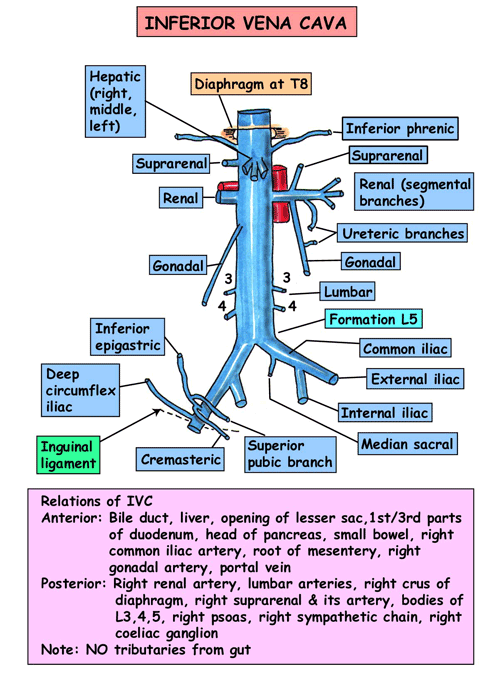The human body has two types of blood vessels – arteries and veins. The arteries carry oxygenated blood or blood rich in oxygen from the heart to the various parts of the body. The veins carry deoxygenated blood or blood rich in carbon dioxide from various parts of the body back to the heart. There are exceptions however such as the pulmonary arteries and umbilical arteries don’t carry oxygenated blood, similar to the pulmonary veins and umbilical veins that don’t carry deoxygenated blood.
Every part of the body has a dedicated artery and vein or a collection of arteries and veins responsible for carrying oxygenated and deoxygenated blood from and to the heart. The collection of veins that carries deoxygenated blood from the lower half of the body to the heart is known as the inferior vena cava. The vein that does the task for the upper half of the body is known as the superior vena cava.
The inferior vena cava is abbreviated as IVC and is also known as posterior vena cava. The inferior vena cava is actually made of two large veins known as the common iliac veins. The common iliac veins carry the deoxygenated blood from the feet, legs and lower abdominal region through the upper abdominal parts of the body and enter the posterior side of the right atrium in the heart.
The inferior vena cava runs along the vertebral column and then connects to the renal vein. Since the vein doesn’t have a central positioning, the inferior vena cava or posterior vena cava has some asymmetries such as the suprarenal and gonadal connect to the inferior vena cava on the right side but the same veins connect to the renal vein on the left.
The inferior vena cava is one of the most important veins in the human body. While like any other vein it is tasked with carrying deoxygenated blood to the heart, the fact that it does so for the entire lower half of the body makes it more important than the tributary veins and smaller networks of veins in the lower half of the body that carry out the same task but on a much smaller scale or for a much smaller area.
The inferior vena cava can be affected by many health ailments or medical conditions. The vein itself can be subjected to damage of varying severity. This vein can get compressed due to physical injury or due to physical deformity and due to some pressures exerted typically by the gravid uterus, an enlarged aorta or due ovarian cancer, renal cell carcinoma and colorectal cancer among others. While the vein is vulnerable to compression, it is strong enough to resist rupturing.
The inferior vena cava is also susceptible to physical stress or due to a medical condition that involves the vertebral column or the abdominal region. If the inferior vena cava develops an occlusion then it can be fatal or life threatening. The inferior vena cava is a deep vein and deep vein thrombosis is also not uncommon. A serious or very serious trauma to the inferior vena cava may lead to exsanguinations.
